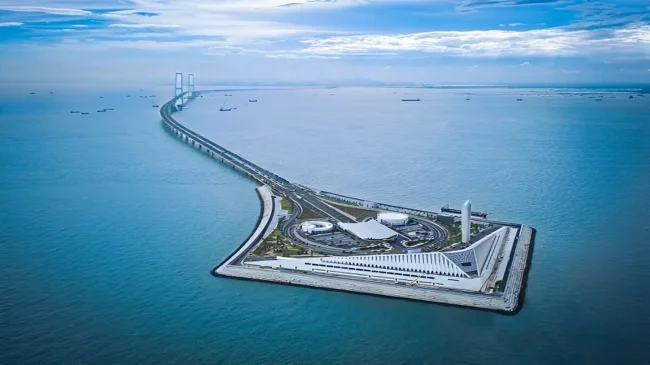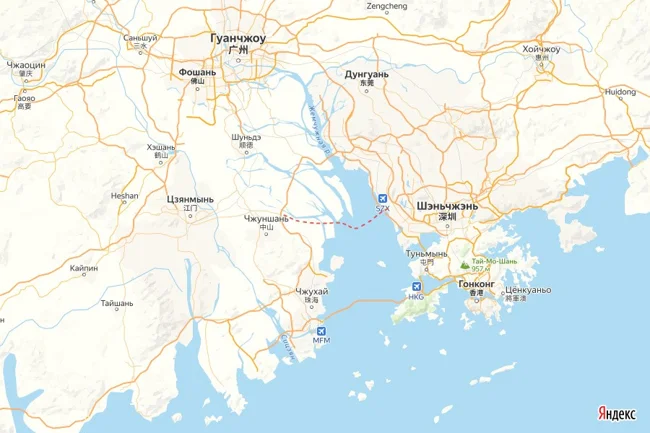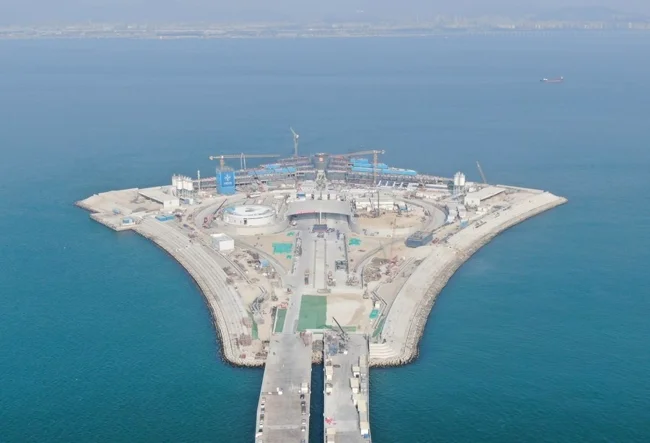A new "Wonder of the World": China has completed one of the most ambitious projects in history! (4 photos)
China has once again surprised the world by implementing an extremely complex project and setting ten world records along the way. The engineers of the Celestial Empire have once again proven their ability to implement the most daring ideas. And the country has confirmed its high technological level in the construction of bridges and tunnels. 
(The project includes the world's first integrated transport interchange "bridge - island - underwater tunnel")
We are talking about one of the world's largest high-speed sea highways with eight traffic lanes. This 24 km long road across a water barrier was built over the course of seven years, although the idea itself arose in the decade before last. But at that time, neither China nor the world had the appropriate technology to implement such a bold idea. Chinese specialists quickly found unique solutions that allowed work to begin on the site.
As a result, the cities of Shenzhen and Zhongshan were connected by the shortest route through a tunnel (6.8 km) and two bridges (17.2 km). The complex also included two artificial islands and the world's first underwater interchange between a highway and an airport. Now you can get from one economic center to another by car four times faster - in just 30 minutes. 
(New transport corridor on the map)
As reported by the Xinhua agency, during the campaign, in which a total of about 10 thousand people were involved, Chinese specialists set several world records:
The commissioned tunnel became the longest (5 km directly under water) and widest (46 m) among similar structures built using similar technology - from a reinforced concrete pipe with a steel casing;
The underwater facility is distinguished by the largest single-volume casting for the steel casing of the submersible element, made using self-compacting concrete - 29 thousand cubic meters per pipe section;
The widest multiple folding M-shaped waterproofing was used at the final junction of the tunnel with the submersible pipe - 3 m;
The length of the main span of the main bridge was 1666 m, which was an absolute achievement for fully marine suspended structures with box girders;
The bridge also has the highest bridge deck - 91 m, and the highest navigation resolution, as well as the highest aerodynamic resistance to wind - 83.7 m/ s;
During the construction of the crossing, the largest anchor device with a volume of 344 thousand cubic meters was used and the largest bridge deck with a coating of hot epoxy asphalt concrete mixture was installed - 378.8 thousand square meters;
In one working day, the builders laid over 22.6 thousand square meters of asphalt (which is comparable to three football fields). 
(Construction work in the fall of 2023. The joining of the two parts of the underwater tunnel was completed in the first half of June 2024. The 5-kilometer submersible section of the tunnel consists of 32 joints and one final joint)
A lot of attention is paid to safety at the site. Particular emphasis was placed on this during the construction of the tunnel, introducing innovative fire extinguishing and smoke removal systems. All information in real time is transmitted to the control center by special robots patrolling the underwater facility. They not only monitor the movement of vehicles, but also promptly identify any problems in the operation of the engineering infrastructure.
The opening of the sea highway is of great importance for the socio-economic development of Guangdong Province, where many leading technology companies are located. In total, almost 70 million people live in the cities adjacent to the bay, and Shenzhen itself, which is called the "Chinese Silicon Valley", has 17 million residents. 
(As observers note, the implementation of such a large-scale project indicates the strengthening of China's political and economic influence)
The new transport corridor, officially opened on June 30, 2024, is located approximately 30 km north of another iconic route - Hong Kong - Zhuhai - Macau, consisting of a series of bridges and tunnels. This 55 km road crosses the Pearl River Delta, connecting the largest cities in the region. It was built from 2009 to 2017. The cost of the project was approximately $17 billion. $6.7 billion was spent on the Shenzhen - Zhongshan road.























